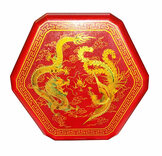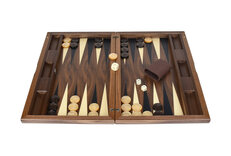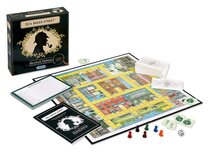The Rules of Chinese Checkers
Chinese Checkers (or Chinese Chequers) was invented in the 1892 in Germany under the name Stern-halma and it was not until 1928 that a version called Chinese Checkers was released in America. The game is quite different to Checkers (draughts), has nothing to do with China and is based on an earlier Victorian game called Halma which is played on a square 16 x 16 chequer board. At Masters Traditional Games, we know that cheap Chinese Checkers games can be found all over the place so for our discerning customers we put effort into finding things that are either high quality or a little bit special in some way. We think that ours is the most interesting selection of Chinese Checkers boards around.
See also: Chinese Checkers.
Equipment
The Chinese Checkers or Chinese Chequers board is in the shape of a six pointed star. Each point of the star is a triangle consisting of ten holes (four holes to each side). The interior of the board is a hexagon with each side five holes long. Each triangle is a different colour and there are six sets of ten pegs with corresponding colours.
Preparation
Chinese Checkers can be played by two, three, four or six players. Obviously, for the six player game, all pegs and triangles are used. If there are four players, play starts in two pairs of opposing triangles and a two player game should also be played from opposing triangles. In a three player game the pegs will start in three triangles equidistant from each other. Each player chooses a colour and the 10 pegs of that colour are placed in the appropriately coloured triangle. Many rules state that any unused triangles must be left populated with their unused pegs so that they cannot be used during the game. We suggest that the game is slightly more interesting if unused triangles are left empty so that pegs can hop through and come to rest in them, if desired.
Objective
The aim of the game is to be the first to player to move all ten pegs across the board and into the triangle opposite. The first player to occupy all 10 destination holes is the winner.
Play
A toss of a coin decides who starts. Players take turns to move a single peg of their own colour. In one turn a peg may either be simply moved into an adjacent hole OR it may make one or more hops over other pegs. Where a hopping move is made, each hop must be over an adjacent peg and into a the vacant hole directly beyond it. Each hop may be over any coloured peg including the player's own and can proceed in any one of the six directions. After each hop, the player may either finish or, if possible and desired, continue by hopping over another peg. Occasionally, a player will be able to move a peg all the way from the starting triangle across the board and into the opposite triangle in one turn! Pegs are never removed from the board. However, once a peg has reached the opposite triangle, it may not be moved out of the triangle - only within the triangle. The question soon arises as to whether it is possible to move a peg into a triangle that is the starting or target triangle for another player. House rules apply but Masters Games suggests the following: A peg can be hopped through such a triangle but is not allowed to come to rest in that triangle.
Anti-Spoiling
Debate has always arisen over the situation where a player is prevented from winning because an opposing player's peg occupies one of the holes in the destination triangle. Most Chinese Checkers rules omit to mention this - implying that it is perfectly legal to block opponents in this dubious fashion. A number of anti-spoiling rules have been proposed - one work-around is to say that should one or more of the holes in the target triangle contain a peg belonging to another player, this does not prevent a player from winning. The game is simply won when all the available points within the triangle are occupied. Masters Games suggests the following additional rule invented by James Masters in 2002 which is wide enough to capture all such situations: If a player is prevented from winning because of the presence of an opposing peg in the destination area, the player is entitled to swap the opposing peg with that of his own peg. This applies for both a single hole move and any part of a hopping move.
Multi-player Variations
For a more involved game, when three players play, each player can control two sets of pegs instead of one. Two players can control three sets of pegs each.
Super Chinese Checkers
Chinese Checkers can be speeded up and subjectively made more interesting by allowing 'long jumps'. In this variation called Super Chinese Checkers, a piece may jump over a piece any number of empty spaces away, provided it can land the same number of empty spaces beyond it in a straight line. Put another way: A piece can jump a single other piece at any distance, provided that the jumped piece lies at the exact midpoint of the jump. The basic 'adjacent jump' allowed in the standard game is just the shortest form of a long jump.
These rules are provided by Masters Traditional Games, an Internet shop selling quality traditional games, pub games and unusual games. For general information or for copying and copyright, see our Rules Information page.
Our rules are comprehensive instructions for friendly play. If in doubt, always abide by locally-played or house rules.
Copyright James Masters, 2025. All rights reserved.


























